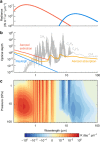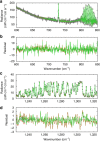Aerosol influence on energy balance of the middle atmosphere of Jupiter
- PMID: 26694318
- PMCID: PMC4703888
- DOI: 10.1038/ncomms10231
Aerosol influence on energy balance of the middle atmosphere of Jupiter
Abstract
Aerosols are ubiquitous in planetary atmospheres in the Solar System. However, radiative forcing on Jupiter has traditionally been attributed to solar heating and infrared cooling of gaseous constituents only, while the significance of aerosol radiative effects has been a long-standing controversy. Here we show, based on observations from the NASA spacecraft Voyager and Cassini, that gases alone cannot maintain the global energy balance in the middle atmosphere of Jupiter. Instead, a thick aerosol layer consisting of fluffy, fractal aggregate particles produced by photochemistry and auroral chemistry dominates the stratospheric radiative heating at middle and high latitudes, exceeding the local gas heating rate by a factor of 5-10. On a global average, aerosol heating is comparable to the gas contribution and aerosol cooling is more important than previously thought. We argue that fractal aggregate particles may also have a significant role in controlling the atmospheric radiative energy balance on other planets, as on Jupiter.
Figures







References
-
- Moses J. I. et al.. in Jupiter-The Planet, Satellites and Magnetosphere eds Bagenal F., Dowling T., McKinnon W. 129–157Cambridge University Press (2004).
-
- Hanel R., Conrath B., Herath L., Kunde V. & Pirraglia J. Albedo, internal heat, and energy balance of Jupiter: Preliminary results of the Voyager infrared investigation. J. Geophys. Res. 86, 8705–8712 (1981).
-
- Yelle R. V., Griffith C. A. & Young L. A. Structure of the Jovian stratosphere at the Galileo probe entry site. Icarus 152, 331–346 (2001).
-
- Zhang X. et al.. Radiative forcing of the stratosphere of Jupiter, part I: atmospheric cooling rates from Voyager to Cassini. Planet. Space Sci. 88, 3–25 (2013).
-
- Conrath B. J., Gierasch P. J. & Leroy S. S. Temperature and circulation in the stratosphere of the outer planets. Icarus 83, 255–281 (1990).
Publication types
LinkOut - more resources
Full Text Sources
Other Literature Sources

